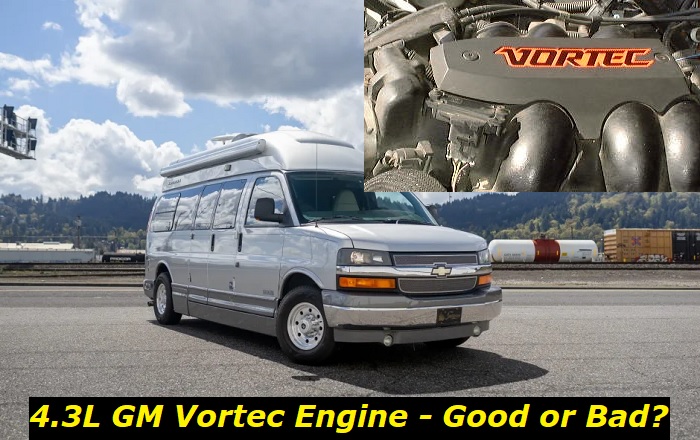The 4.3L Vortec 262 CID engine is considered to be GM's most durable and longest-running power unit under the Vortec family of engines. The application of the engine in new vehicles ended in 2014 but it is still widely used today. Even the early models of the product are still utilized by many vehicles on the road, albeit, some have already undergone rebuilding.
The 4.3L Vortec engines are remarkably reliable for the most part, but there are still a few issues frequently encountered by its users that are worth highlighting. We will cover them all here as well as the longevity and key specs of the unit for everyone's reference.

Key features and my opinion about the engine
- Production years:1985-2014
- Average lifespan of 4.3L Vortec:250,000-290,000 miles
- Fuel supply type:port injection (early models - TBI)
- Power range:130-200 hp
- Fuel efficiency:awful
- Engine block material:cast-iron
- Engine reliability score:high
- The most common problems:various leaks, oil consumption, issues with ignition, minor problems.
Most Common Problems Found in the 4.3L Vortec Engine
Based on the history of the 4.3L Vortec engine as well as reports and reviews associated with it, here are the most common problems it is prone to:
1. Carbon Build-Up
Carbon build-up is a fairly common problem with engines, especially those that are frequently used for heavy workloads or recreation. Old units also have a higher risk of accumulating dirt within their internal parts. However, the L35 and LF6 versions of the 4.3L Vortec engine produced between 1996 to 2002 were especially prone to this problem.
Carbon build-up can lead to many problems in an engine. It can block the flow of fluids like fuel and oil, cause lubrication issues in the moving parts of the vehicle, and block airflow depending on the location and severity of the contamination. In worst-case scenarios, heavy carbon deposits can result in the internal components of the engine seizing or overheating. Both of which can ultimately lead to expensive repairs.
Some of the common symptoms of carbon build-up are acceleration issues, rough idling, hard starts, misfires, reduced fuel economy, and Check Engine light. Once the signs of this problem have become too evident, it's time for you to bring your auto to a mechanic for engine cleaning.
The amount of work required to remove carbon deposits varies. For serious problems though, it may necessitate the use of pressurized air or a cleaning solution in the affected areas.
On the other hand, if it has already caused serious damage to the engine, your mechanic may have to rebuild your 4.3L Vortec from the ground up or replace it if repairs are no longer a practical option.
2. Idle Control Valve Failure
The idle control valve is responsible for regulating the engine's idle speed. It is a small, computer-controlled valve that is located on the throttle body. The valve opens and closes to allow air to bypass the throttle plate. This regulates the amount of air that enters the engine, which in turn affects the engine's speed.
When the idle control valve fails, it can cause a lot of problems. The most common symptom is an erratic or surging idle speed. The engine may also run rough or stall altogether. These problems can be caused by a build-up of carbon deposits on the throttle body or intake valves. These deposits can restrict air flow, causing the engine to run lean and producing the aforementioned symptoms.
If the problem is not addressed, it can lead to further engine damage. The deposits can cause the valves to stick, or the throttle body to become clogged. This can cause the engine to overheat, or even seize up.
Aside from carbon accumulation, another possible cause of the problem is a faulty air intake sensor. This sensor tells the computer how much air is entering the engine. If it is not working properly, it can cause the idle control valve to fail.
The solution to this problem depends on the cause. If the problem is due to carbon deposits, they can be remedied using the process shown in the previous item of this list. If the problem is caused by a faulty air intake sensor, it will need to be replaced. In some cases, the entire throttle body will need to be changed with a new one if it is damaged beyond repair.
If you suspect that your idle control valve is failing, have it checked by a qualified mechanic as soon as possible. Do not ignore the problem, as it will only get worse over time. Addressing the problem early on can save you time and money in the long run.
3. Intake Manifold Gasket Leak
In general, the intake manifold gasket of the 4.3L Vortec can show signs of wear as early as 50,000 miles. Meanwhile, its recommended replacement is every 80,000 miles.
The intake manifold gasket is a seal that is located between the engine and the intake manifold. This gasket seals the connection between these two components to prevent oil, coolant, and other fluids from leaking into the intake manifold. The 4.3L Vortec engine is equipped with an intake manifold gasket made of rubber.
If you notice oil leaks coming from around the area where the intake manifold bolts to the engine, this is a sign that the intake manifold gasket has failed and needs to be replaced.
Additionally, if the intake manifold gasket leak is not addressed, it can lead to engine overheating. This is because the coolant that is leaking from the gasket is prevented from properly circulating through the engine.
The best way to prevent an intake manifold gasket leak is to have the gasket changed at the recommended replacement interval. In some cases, you may also need to replace other components that have been damaged by the leak, such as the intake manifold itself or the head gasket.
4. Distributor Malfunction
The engine distributor is responsible for providing the spark that ignites the air and fuel mixture in the engine cylinders. In order for this ignition to happen at the right time, the distributor must rotate at exactly half the speed of the crankshaft. If the distributor fails to do its job, it can cause problems with the engine.
A major symptom of a malfunctioning distributor is misfiring. This happens when the spark plugs do not fire at the correct time, and as a result, the air/fuel mixture in the cylinder does not ignite properly. This can lead to a loss of power and decreased fuel efficiency. Additionally, this event can cause damage to the catalytic converter.
One more sign of a problem with the distributor is engine shaking. This is caused by the spark plugs firing at the wrong time, which causes the cylinders to fire out of order. This can lead to a loss of power and decreased fuel efficiency.
If the distributor problem is not addressed immediately, it can bring about serious damage to the engine. In some cases, the damage may be irreparable and will require a complete engine rebuild or replacement.
There are some lighter solutions to this problem if the damage is not yet widespread. One is to replace the distributor cap, spark plugs, catalytic converter, and rotor. Another is simply adjusting the timing of the engine. Finally, if the problem is severe enough, you may need to replace the entire distributor.
If you are experiencing any of these symptoms, it is important to take your car to a mechanic or dealership as soon as possible. Ignoring the problem can lead to serious and expensive engine damage.
4.3L Vortec 262 CID Engine Longevity
The 4.3L Vortec is built to last for over 185,000 miles in general. Some claim that its lifespan may be stretched for up to 300,000 miles, but this comes with regular servicing and repairs on some of its major components like the distributor, water pump, gearbox, ignition control modules, and a few others.
If you are yet to purchase the engine, make sure to get its latest version with as little mileage as possible to reduce the risk of the problems enumerated in the previous section. As for the older models that have been rebuilt already, be sure to inspect them thoroughly to ensure that the issues discussed here are no longer as prevalent as before and that it is free from other additional problems.
4.3L Vortec Engine Specs
The 4.3 Vortec, otherwise known as the Vortec 4300 262 CID, is a six-cylinder, small-block with a V-formation engine that debuted in 1985 and was manufactured up until 2014. In its near four-decade production run, the engine has undergone several revisions including the LB1 used from 1985 to 1986, the LB4 made from 1985 to 1995, the L35 assembled from 1992 to 2002, the LF6 rolled out from 1996 to 2002, and the LU3/LG3 utilized from 2003 to 2014.
Among the popular vehicles that carried the 4.3L Vortec were the Silverado, Sierra, Blazer, Sonoma, S10, and the iconic El Camino. In its various applications, the maximum outputs achieved by the engine were 305 hp and 360 lb-ft of torque.
Conclusion
The 4.3L Vortec engine enjoys a huge approval rating from petrolheads. However, it is also known for the issues mentioned here, which you should consider if you are concerned about the resulting maintenance costs.
On the bright side, it should be noted that the newer versions of the engine have less tendency to develop the problems discussed here. Some rebuild variants may have also addressed the issues, too.
Nonetheless, don't put your guard down with this engine. Should you notice signs of its common problems, don't hesitate to bring it to a mechanic for repairs. Furthermore, don't skimp on its regular maintenance to ensure its optimum performance and reliability.
Lastly, when replacing parts, always use OEM (original equipment manufacturer) quality parts. Using aftermarket or recycled products can cause more problems than they solve. Not only are they often of inferior quality, but they may bring about compatibility issues. These can lead to further engine damage, and void your warranty.
About the authors
The CarAraC research team is composed of seasoned auto mechanics and automotive industry professionals, including individuals with advanced degrees and certifications in their field. Our team members boast prestigious credentials, reflecting their extensive knowledge and skills. These qualifications include: IMI: Institute of the Motor Industry, ASE-Certified Master Automobile Technicians; Coventry University, Graduate of MA in Automotive Journalism; Politecnico di Torino, Italy, MS Automotive Engineering; Ss. Cyril and Methodius University in Skopje, Mechanical University in Skopje; TOC Automotive College; DHA Suffa University, Department of Mechanical Engineering






Add comment